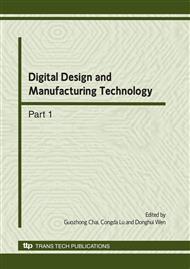p.653
p.658
p.663
p.669
p.675
p.681
p.686
p.690
p.695
Numerical Prediction of Manufacturing Error in Sliding Panel Structure
Abstract:
The present work focuses on the numerical prediction of the manufacture quality of a sliding panel structure, in which the mobile components are floating on the immobile components and the 0.002mm thickness oil-film clearance between the mobile and immobile components. The interaction between them is the interfacial coupling interaction. A single-point spring-damping supporting element is introduced to simulate this type of interaction traditionally, in which the torsion of the mobile components is increasing with the supporting element reduced. To analogy the interfacial coupling interaction, the finite centrality supporting method is introduced to study the thin oil-film effect between the mobile and immobile components. And the manufacturing quality is predicting through the numerical study. Compared with the results derived from the numerical and experiments, the manufacturing error is in accordance with each other.
Info:
Periodical:
Pages:
675-680
Citation:
Online since:
March 2010
Authors:
Price:
Сopyright:
© 2010 Trans Tech Publications Ltd. All Rights Reserved
Share:
Citation:


